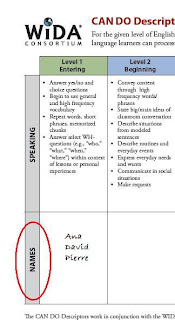If you are looking for a quick and easy summer read about young English language learners (ELLs), then you may want to take a look at this book. Like many of you, summer is my chance to catch up on personal and professional reading. Earlier this week, the book Basics of Supporting Dual Language Learners: An Introduction for Educators of Children from Birth through Age 8 found its way onto my desk. It is written by Karen N. Nemeth and published by the National Association for the Education of Young Children (NAEYC).
First let me briefly clarify that the term dual language learners (DLL) is used by some preschool and early childhood programs instead of ELL. In fact, DLL is the official term used by NAEYC, the Office of Head Start and the Council for Exceptional Children Divison for Early Childhood. In a nutshell, DLL is used to describe a young child who is growing up with exposure to, and simultaneously learning,
more than one language in their home and community. It is not a reference to students in dual language immersion programs.
As I flipped through the book, the illustrations caught my eye and piqued my curiosity. The cover of the book shows a teacher pointing and saying “Bird.” while the children respond with the word for bird in each of their home languages. Inside the book there is a drawing that shows three children arm in arm. Each child is smiling and wearing a shirt that proclaims the languages that they speak: Farsi, French, Russian and English. Another drawing depicts a teacher carrying a baby to the changing table. Above the changing table is a poster listing simple statements in English and in Spanish that can be used to let the child know what is happening (e.g. Changing time / Es hora de cambiar el pañal).
I was pleased to see that the book was divided into three main sections. The first focuses on the basics including the value of the home language, first language development and second language development. The second (and largest) section is full of strategies and techniques for supporting students in the early childhood classroom. Some strategies are for monolingual English teachers and some are for bilingual teachers. The author even addresses how to support preservice teachers, inservice teachers, and bilingual volunteers. This section would be particularly useful for administrators and program supervisors. Nemeth even includes a checklist to see if your room is ready for DLLs. (I am a sucker for great checklists!) The FAQ section at the end of the book provides wonderful answers to ten questions – many of which I am often asked in my own workshops. Check it out and let me know what you think.
Special thanks to Brian Michalski, Early Childhood Project Director at the Illinois Resource Center for this book!
For more on early childhood education and English language learners, click hereand here.
For more on working with parents of ELLs, including native language resources, click here and here.
For more on working with parents of ELLs, including native language resources, click here and here.
Image: FreeDigitalPhotos.net





























